What is a skin biopsy?
The word “biopsy” is one of those worrisome words that people often associate with cancer.
While it’s true that your dermatologist will perform a skin biopsy if a growth on your skin might be skin cancer, this medical procedure helps dermatologists diagnose many different skin conditions.
If your dermatologist thinks you need a skin biopsy, they can perform this procedure during an office visit while you remain awake.
During a skin biopsy, your dermatologist removes a small amount of skin, which will be looked at under a microscope. This magnified view is the only way to diagnose some skin diseases, including skin cancer, infections, and conditions that cause blisters. A skin biopsy may also be used to find out what’s causing a rash.
During a skin biopsy, your dermatologist will:
1. Disinfect and numb the area
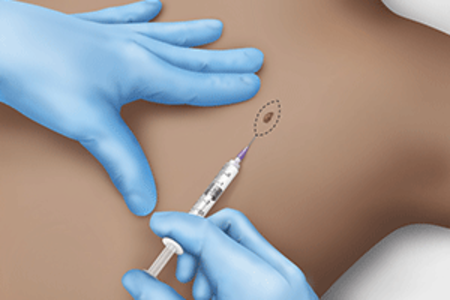
Dermatologist numbs a small area
Your dermatologist begins by wiping the area with rubbing alcohol or another antiseptic. After disinfecting your skin, your dermatologist will give you an injection to numb the area. While your dermatologist is injecting, you may feel some burning or stinging.
2. Remove all (or some) of the skin that requires a closer look
The technique that your dermatologist uses to remove the skin varies with what type of disease your dermatologist suspects you may have and the size of the growth.
The five main types of skin biopsies are:
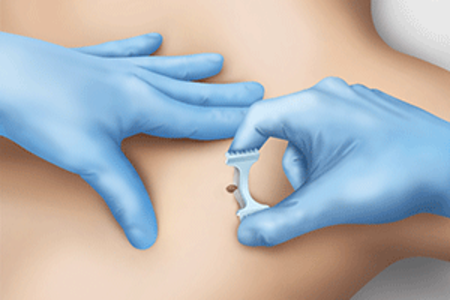
Shave biopsy
Your dermatologist may use a tool that looks a bit like a razor blade to shave off a thin layer of the growth. This type of skin biopsy removes the top layers of skin.

Punch biopsy
If your dermatologist needs to go deeper into the skin to get a good sample, they use a tube-shaped tool. This tool is called a punch and works like a cookie cutter. Punch biopsy samples contain multiple layers of skin.
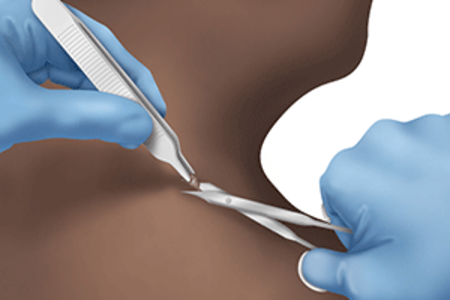
Scissors biopsy
Also called a snip biopsy, this type of skin biopsy is used to remove a hanging growth from the skin. Just as the name implies, your dermatologist uses surgical-grade scissors to cut off the hanging growth.
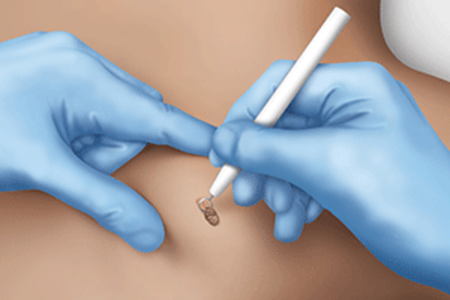
Curette biopsy
Your dermatologist uses a medical tool called a curette to scrape a growth on your skin. This tool looks like a pen with a metal loop on the end. For this type of biopsy, you may not need an injection to make you numb.
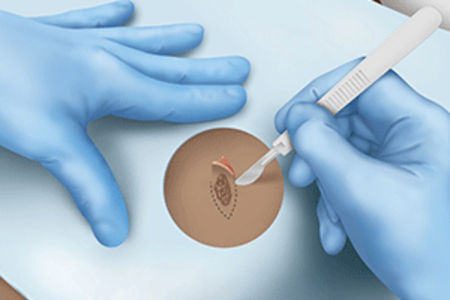
Excisional (or incisional) biopsy
If your dermatologist needs to go even deeper, they use a scalpel or curved blade to remove the growth or other skin concern. When your dermatologist removes the entire growth, it’s called an excisional biopsy.
Sometimes, it’s not possible to remove the entire growth during the skin biopsy. When your dermatologist can remove only part of the growth, it’s called an incisional biopsy.
An excisional biopsy or punch biopsy (described above) may be used to remove tissue from under or around a fingernail or toenail, too.
3. Treat your wound
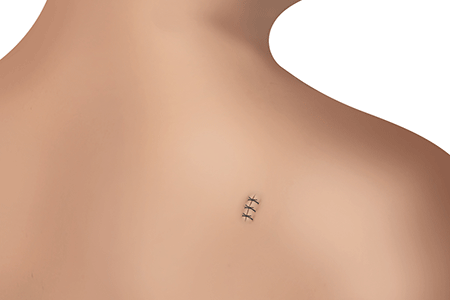
Some patients need stitches
Your dermatologist will stop the bleeding and treat your wound as needed. Treatment may include applying pressure or a medication to your wound. If you had either a punch or excision biopsy, your dermatologist may close the wound with stitches.
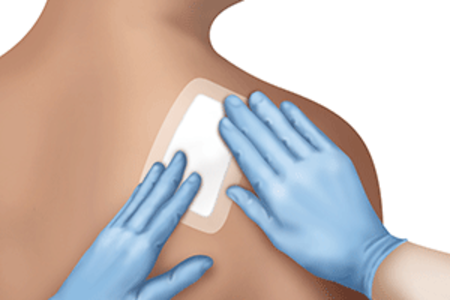
Moist, covered wounds heal more quickly
To keep your wound miost, your dermatologist will apply petroleum jelly to the wound and then cover it with a bandage.
4. Give you instructions for at-home wound care
You need to keep the wound covered for as long as your dermatologist recommends. Each day, you may need to cleanse the wound, apply a small amount of petroleum jelly, and put on a new bandage.
Keeping the wound moist helps it heal faster.
5. Send the removed skin to a lab where a doctor will examine it under a microscope

A microscopic view is needed to diagnose some skin diseases
A dermatopathologist is a medical doctor who specializes in dermatology and pathology (diagnosing diseases).
Dermatologists work closely with dermatopathologists, who use microscopes to examine the skin removed during a skin biopsy. This close-up view and years of training allow dermatopathologists to diagnose many different skin diseases.
After making the diagnosis, a dermatopathologist writes a report that explains the medical findings. Your dermatologist will review this report to determine if you need further treatment.
6. Contact you with the biopsy results
Once your dermatologist reviews your biopsy report, you will be contacted and told the results. For some patients, that’s all you need. For example, if your dermatologist performed a skin biopsy to find out if the spot was skin cancer and the report says it’s not, you don’t need to do anything else.
If you need treatment, be sure to schedule a follow-up appointment with your dermatologist.
If you are concerned about any spots on your skin, or notice any spots that are changing, itching, or bleeding, make an appointment to see a board-certified dermatologist.
You can locate a dermatologist in your area by going to Find a dermatologist.
Related AAD resources
Images
Illustrations: Property of the American Academy of Dermatology.
References
Olbricht S. “Biopsy techniques and basic excisions.” In: Bolognia JL, et al. Dermatology. (fourth edition). Mosby Elsevier, China, 2018:2478-94.
Schmidt DKT. Wentzell M. “Fundamentals of cutaneous surgery.” In: Fitzpatrick JE, et al. Dermatology Secrets Plus (5th edition). Elsevier. China, 2016:458-9.
Spates ST. “Diagnostic techniques.” In: Fitzpatrick JE, et al. Dermatology Secrets Plus (5th edition). Elsevier. China, 2016:31.
Written by:
Paula Ludmann, MS
Reviewed by:
Erin Ducharme, MD, FAAD
Matthew Elias, MD, FAAD
Laurel Geraghty, MD, FAAD
Pearl E. Grimes, MD, FAAD
Sandy Marchese Johnson, MD, FAAD
Carrie Kovarik, MD, FAAD
William Warren Kwan, MD, FAAD
Marina Li, MD, FAAD
Shari Lipner, MD, PhD, FAAD
Bassel Hamdy Mahmoud, MD, PhD, FAAD
Rajiv Nijhawan, MD, FAAD
Sanna Ronkainen, MD, FAAD
Dara D. Spearman, MD, FAAD
Last updated: 3/4/22
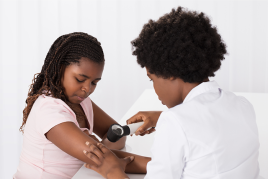 Molluscum contagiosum: How to safely treat it
Molluscum contagiosum: How to safely treat it
 Biosimilars: 14 FAQs
Biosimilars: 14 FAQs
 Practice Safe Sun
Practice Safe Sun
 Relieve uncontrollably itchy skin
Relieve uncontrollably itchy skin
 Fade dark spots
Fade dark spots
 Untreatable razor bumps or acne?
Untreatable razor bumps or acne?
 Laser hair removal
Laser hair removal
 Scar treatment
Scar treatment
 Botox
Botox
 Free materials to help raise skin cancer awareness
Free materials to help raise skin cancer awareness
 Dermatologist-approved lesson plans, activities you can use
Dermatologist-approved lesson plans, activities you can use
 Find a Dermatologist
Find a Dermatologist
 What is a dermatologist?
What is a dermatologist?